Text

Every Frame a Painting — Blade Runner 2049
In "Blade Runner 2049," Officer K, played by Ryan Gosling, searches for Deckard, portrayed by Harrison Ford, amidst the ruins of Las Vegas. The decaying, half-buried buildings provide a striking backdrop, evoking feelings of abandonment and loss. Wide-angle shots accentuate the scale of destruction, emphasizing K's vulnerability in the vast, desolate landscape.
The scene's mood is shaped by the soft, diffused light of the setting sun, which bathes the scene in warm hues and imbues it with a sense of melancholy. Vibrant oranges add to the surreal atmosphere, evoking the imagery of a desert sandstorm and intensifying the feeling of desolation and otherworldliness.
Symbolically, the ruins of Las Vegas represent humanity's hubris and decline, reminding viewers of the impermanence of civilization and the fleeting nature of human achievement. K's search for Deckard amidst this desolation reflects his own existential journey for meaning and identity.
Overall, this scene is visually stunning and thematically rich, exploring themes of identity, memory, and the fragility of human civilization through its evocative imagery and symbolism.
3 notes
·
View notes
Text
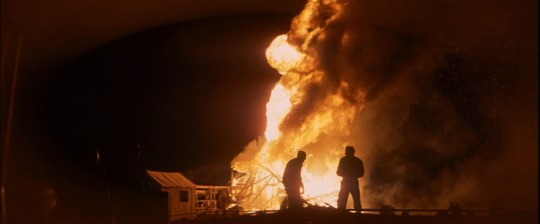
Every Frame a Painting — There Will Be Blood
This shot from the movie “There Will Be Blood” shows a wide view of an oil explosion against a black sky, with silhouetted figures and a flaming rig in the background. This composition emphasizes the explosion’s enormity, the intensity of the flames, and the vulnerability of the men. The decision to use a wide shot highlights the scale of the explosion, showing both the rig and the expansive landscape. By placing the flaming rig at the center, the viewer’s attention is focused on the unfolding chaos and danger. The stark contrast between the black sky and the flames intensifies the ominous atmosphere of the scene. The silhouetted figures against the blazing rig and dark sky evoke a sense of peril, emphasizing the men’s insignificance in the face of the explosion’s overwhelming power.
3 notes
·
View notes
Text
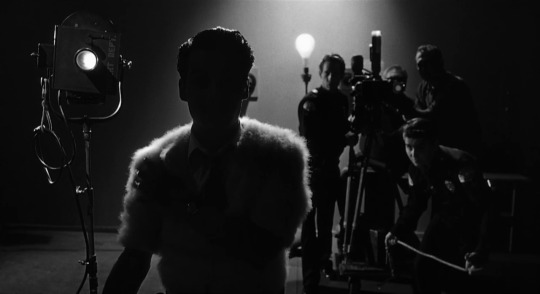
Every Frame a Painting — Ed Wood
The scene in "Ed Wood" where Johnny plays Ed is remarkable. In the shot, Ed is standing in front of a group of technicians, and he is bathed in backlighting. His face is not visible, but the soft glow highlights the silhouette of his figure, highlighting the texture of his sweater. The light is shining over his shoulder, and despite not being able to see his face, you can tell from his body position that he is fully engaged in what he is watching.
0 notes
Text
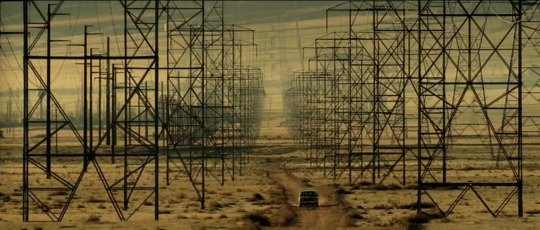
Every Frame a Painting — Se7en
In the pivotal scene of "Se7en," Detectives Mills and Somerset find themselves driving through a remote desert landscape with serial killer John Doe in custody. The desolate setting intensifies the moment's significance and magnifies the feeling of isolation. As the car navigates through a field of electrical towers, the towering structures cast a sense of foreboding, similar to a spider's web trapping its prey. This imagery symbolizes the characters' entrapment and the looming threat posed by John Doe, creating an atmosphere of confinement and danger. The scene expertly conveys tension and uncertainty, foreshadowing the film's climactic resolution while serving as a visual metaphor for the psychological dynamics between the characters and the cunning nature of John Doe.
0 notes
Text
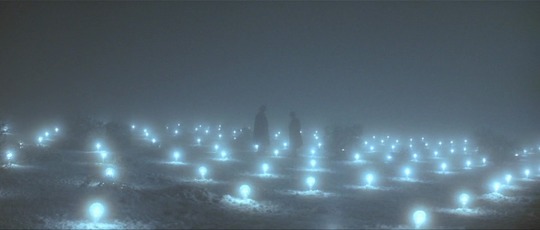
Every Frame a Painting — The Prestige
The field of light bulbs scene from “The Prestige” is a visually striking and thematically significant moment that encapsulates several important motifs of the film. The contrast between the bright bulbs and the dark silhouettes emphasizes the sharp difference between light and shadow, echoing the themes of duality and opposition that are at the center of the narrative. The numerous light bulbs, which often symbolize enlightenment, may represent knowledge or insight, but the scene’s haziness adds a degree of ambiguity, implying that not all illumination leads to clarity. Despite the stillness of the silhouettes and the stationary bulbs, a subtle sense of motion, implied by the hazy atmosphere, permeates the scene, contributing to its eerie and surreal atmosphere. Through careful composition and lighting, director Christopher Nolan and cinematographer Wally Pfister create a stunning and thematically profound image.
0 notes
Text
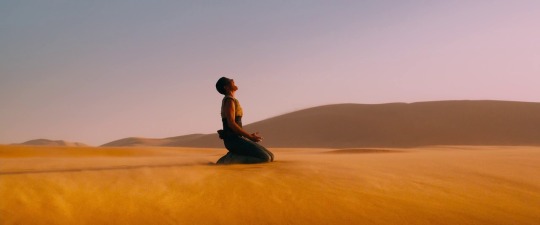
Every Frame a Painting — Mad Max: Fury Road
In a crucial moment of “Mad Max: Fury Road,” Furiosa, played by Charlize Theron, finds out that the Green Place has disappeared. She collapses in the desert, overwhelmed by despair and screaming out her anguish. The wide-angle shot of the barren landscape emphasizes the desolation of her surroundings, highlighting the enormity of her loss.
This scene is a turning point in Furiosa’s character arc. Although she has been portrayed as a strong and determined leader throughout the film, her vulnerability is exposed as she struggles with losing her home. Without her usual resolve, Furiosa’s pain is evident, adding complexity to her character and reinforcing the themes of survival, loss, and resilience in the post-apocalyptic world of the movie.
2 notes
·
View notes
Text

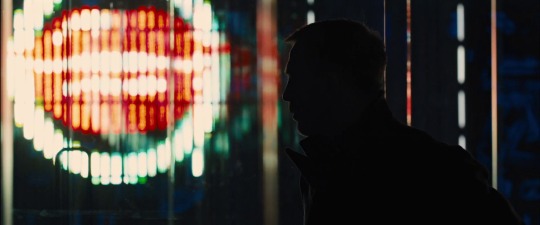
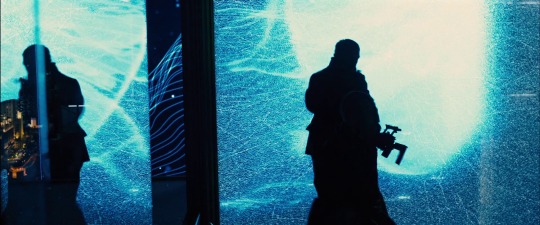
Every Frame a Painting — Skyfall
In an early scene of the movie Skyfall, James Bond engages in hand-to-hand combat with a henchman inside a Shanghai city skyscraper. The scene is set amidst the bright images of a giant jellyfish and colored lights shining from screens and reflecting off windows. Bond’s mission is to capture Patrice, a skilled assassin who recently killed an Asian art collector. Their pursuit leads them to the top floors of a skyscraper under construction. The towering heights and extensive views create a tense atmosphere, further heightened by the glass walls reflecting the city’s neon lights. The fight between Bond and Patrice is a clash of highly trained combatants characterized by precision and speed. The dynamic choreography, featuring fast-paced action and close-quarters combat, adds to the scene’s intensity. The sleek skyscraper architecture and the chaotic fight create a striking contrast, providing a captivating backdrop for the conflict. The outcome of the confrontation sets the stage for Bond’s ongoing pursuit of Patrice, underscoring the stakes and foreshadowing the challenges ahead in uncovering the truth behind Patrice’s actions.
5 notes
·
View notes
Text



Every Frame a Painting — The Godfather
The closing scene of "The Godfather" effectively brings together the themes of power, family, and moral decay that are present throughout the film.
At the beginning of the scene, we see Michael Corleone, who has now become the Don, lying to his wife, Kay, about his involvement in the murder of his sister's husband, Carlo. This moment highlights Michael's transformation from an outsider to a calculating leader, and shows the lengths he is willing to go to protect his family and maintain his power.
As Michael's men address him as "Don Corleone," it signifies his official ascension to the head of the Corleone crime family. However, this moment is not one of triumph, but of tragic repetition. It is juxtaposed with the film's opening scene, where his father, Vito Corleone, held court in his office. By mirroring this scene, the film not only emphasizes the cyclical nature of power and corruption within the Corleone dynasty, but also evokes a sense of sadness for the unending cycle of tragedy.
The final shot, where Kay looks at Michael through a closing door, is perhaps the scene's most poignant and symbolic moment. The closing door represents the barrier between Michael and Kay, symbolizing her exclusion from his world of crime and deception. It's a visual metaphor for the irreparable rift that has formed between them due to Michael's choices and actions.
The closing scene of "The Godfather" encapsulates the tragic journey of Michael Corleone from a promising young man with moral convictions to a ruthless mafia boss who sacrifices everything for power and control. It's a chilling and haunting conclusion that contemplates the cost of ambition and the corrupting influence of absolute power.
#the godfather#michael corleone#kay corleone#kay adams#diane keaton#al pacino#francis ford coppola#every frame a painting
14 notes
·
View notes
Text

Every Frame a Painting — The Searchers
In the final moments of "The Searchers," the doorway scene symbolizes Ethan Edwards' internal struggle and realization of the consequences of his actions. Bringing Debbie home, he hesitates at the threshold, unable to fully reintegrate into society due to his past obsessions and hatred. The doorway serves as a barrier between darkness and light, highlighting Ethan's liminal status. The closing shot, mirroring the opening, suggests a cyclical journey for Ethan, marked by isolation and alienation. This scene underscores the film's central themes of belonging, identity, and redemption, as Ethan remains haunted by his past.
#classicfilmsource#the searchers#john ford#john wayne#old hollywood#vintage movies#classic film#vintage hollywood#every frame a painting
2 notes
·
View notes
Text

Every Frame a Painting — Fight Club
In the final scene of "Fight Club," the narrator and Marla watch calmly as buildings are destroyed. This symbolizes a desire to embrace chaos and break free from societal constraints. It represents the narrator's journey towards liberation from existential angst and consumer culture. Throughout the film, he struggles with emptiness and finds solace in Fight Club and Project Mayhem. This moment marks his peace, liberated from societal expectations. In the final shot, we see the culmination of his journey, where he appears at peace, finally freed from the constraints of consumerism and societal expectations. The ambiguity of the scene invites interpretation, with some seeing it as a triumphant liberation and others as nihilistic. The fact that the narrator and Marla are together in this final moment suggests a sense of solidarity and mutual understanding. Despite their flaws and tumultuous relationship, they have found a connection in their shared rejection of societal norms.
2 notes
·
View notes
Text

Every Frame a Painting — Blade Runner
In the movie “Blade Runner,” there is a significant scene where Rachael, played by Sean Young, smokes a cigarette during the Voight-Kampff Test, which carries a lot of symbolism, enriching our understanding of the characters and themes in the film.
Rachael’s character is complex and intriguing, portraying the classic archetype of a “mysterious woman who walks into a private eye’s office.” She adeptly navigates between the roles of an innocent ingénue and a metaphorical femme fatale. The cinematography highlights this duality, with Rachael’s face illuminated by a sharp edge of light on her right cheek, contrasting with enigmatic shadows on the left, making her presence seem almost otherworldly.
Smoking carries a lot of symbolic weight and is often associated with rebellion, introspection, and existentialism. Rachael’s decision to smoke during the test suggests that she may be defying or uncomfortable with the interrogation process, potentially indicating her desire to take control in a vulnerable situation. The billowing smoke further obscures her identity, adding to the scene’s mysterious ambiance, which aligns with the film’s signature hazy aesthetic.
Strategically placed eyelights subtly enhance Rachael’s gaze, lending her an almost alien quality. This choice deepens the exploration of the movie’s primary theme of artificiality versus humanity, echoing Rachael’s internal struggle with her identity and existence.
The Voight-Kampff Test, which measures emotional responses to discern replicants from humans, becomes more complex in Rachael’s case due to her smoking potentially affecting her physiological reactions. This adds tension to the scene as both she and the examiner, Deckard, grapple with the uncertainty surrounding her identity.
1 note
·
View note
Text
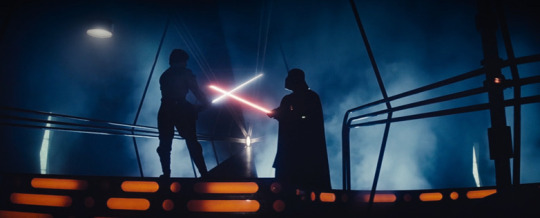
Every Frame a Painting — Empire Strikes Back
The lightsaber duel between Luke Skywalker and Darth Vader in "The Empire Strikes Back" is a crucial moment in the Star Wars saga. It takes place in the carbon-freezing chamber of Cloud City and is a climactic battle between good and evil. The duel holds significant emotional and narrative relevance, symbolizing the age-old struggle between light and dark. Luke represents the forces of good, while Vader personifies the depths of evil. Their conflict further mirrors the complicated relationship between mentor and student, as well as that of father and son. The eerie ambiance of the chamber, characterized by the amber light, and the swirling smoke adds to the tension and emphasizes the emotional undertones of the scene. Although the choreography may seem simplistic compared to modern fight scenes, it is still effective in conveying the raw intensity of the confrontation. Wide shots further highlight the physicality of the duel, showcasing the combatants' skill. Ultimately, this expertly crafted sequence blends action, emotion, and symbolism to create a memorable moment in the Star Wars saga.
14 notes
·
View notes
Text

Every Shot a Painting — Inception
The rotating hallway scene from the film ‘Inception’ is one of its most visually stunning and iconic sequences. In this scene, Arthur (played by Joseph Gordon-Levitt) engages in a fight with projections in a gravity-defying setting, showcasing the movie’s technical brilliance. Director Christopher Nolan’s use of practical effects, with a massive rotating rig for the set, creates a realistic sense of movement and allows the actors to interact convincingly with their environment.
The fight choreography was also expertly choreographed to take advantage of the unique dynamics of the rotating hallway. Joseph Gordon-Levitt’s performance as Arthur is particularly noteworthy, as he navigates the shifting orientation of the environment while engaging in hand-to-hand combat with the projections. The scene perfectly blends intricate fight choreography with stunning practical effects, making it a masterclass in action filmmaking.
Thematically, the rotating hallway sequence serves as a metaphor for the fluid and unpredictable nature of dreams. As Arthur fights his way through the spinning corridor, he must adapt to the changing gravity and orientation of the environment, reflecting the surreal and shifting realities of the dream world. Additionally, the scene highlights Arthur’s resourcefulness and quick thinking as he strategizes to overcome the obstacles in his path.
Overall, the rotating hallway sequence in “Inception” is a standout moment in the film, showcasing Christopher Nolan’s skill as a director and his ability to push the boundaries of visual storytelling.
8 notes
·
View notes
Text
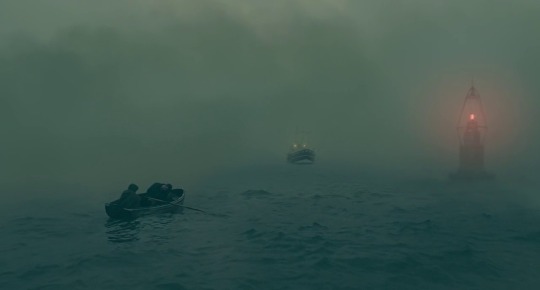
Every Frame a Painting — Children of Men
The final scene of the movie "Children of Men" is a powerful moment that encapsulates the themes of hope, renewal, and the resilience of the human spirit that run throughout the film. In this scene, Kee, played by Claire-Hope Ashitey, holds her newborn baby in her arms while the Tomorrow hospital ship approaches in the distance. This symbolizes a glimmer of hope and the possibility of a better future. The shot is masterfully composed and executed, using a long take to add to the intensity and immediacy of the moment, allowing the audience to fully immerse themselves in Kee's experience. Thematically, the shot is rich with symbolism. Kee's baby is the first child to be born in nearly two decades, making her a symbol of hope and the possibility of renewal in a world plagued by infertility and despair. The Tomorrow hospital ship represents a beacon of hope and a chance for a fresh start. Its arrival suggests that there are still pockets of humanity working towards a better future despite the overwhelming odds stacked against them. The fact that the ship is named "Tomorrow" further emphasizes the idea of looking toward the future with optimism and determination.
0 notes
Text

Every Frame a Painting — The Apartment
"The Apartment" is a 1960 American romantic comedy-drama film, directed by Billy Wilder and starring Jack Lemmon and Shirley MacLaine. A pivotal moment in the film is the broken-compact mirror shot, which adds depth to the character of C.C. Baxter (played by Jack Lemmon) and illustrates his internal conflict. In this scene, Baxter is confronted with his own reflection in a broken compact mirror, shortly after he realizes the depth of his own moral compromise. Baxter has been allowing his superiors to use his apartment for extramarital affairs in exchange for career advancement. He has been emotionally disconnected from the consequences of his actions until this moment. The broken mirror, a powerful visual metaphor, symbolizes more than just self-reflection and self-awareness. It signifies a fractured sense of self, a shattered moral compass. Baxter is forced to confront the reality of his actions and the toll they have taken on his integrity in a way that is both intense and profound. The shot itself is not just a shot, but a carefully composed piece of art that intensifies the audience's understanding of Baxter's isolation and inner turmoil. The fragmented reflection in the broken mirror, the disjointed and distorted image, all mirror Baxter's fragmented psyche, his inner conflict, and self-doubt in a way that is both powerful and poignant. Furthermore, the broken-compact mirror shot is significant in its placement within the narrative. It marks a turning point for Baxter, where he begins to question the cost of his ambition and the morality of his choices. It sets the stage for his eventual redemption as he strives to reclaim his integrity and reconcile with the consequences of his actions.
#classicfilmsource#classicfilmblr#classic movies#classic film#jack lemmon#billy wilder#every frame a painting#the apartment#cc baxter
2 notes
·
View notes
Text

Every Frame a Painting — Raiders of the Lost Ark
In the iconic scene from "Raiders of the Lost Ark," Indiana Jones stands against the setting Egyptian sun, watching over the excavation for the Ark of the Covenant. Harrison Ford's character's silhouette catches immediate attention, shrouded in mystery and heroism. The choice of the Egyptian sun as a backdrop adds to the scene's grandeur. Its warm, golden hues evoke a sense of adventure. The shot is carefully composed to emphasize Indiana Jones' significance, portraying him as a lone adventurer who is confronting immense challenges. Symbolically, his silhouette against the setting sun characterizes him as a rugged and determined archaeologist who embodies the pursuit of noble goals amidst difficult circumstances.
3 notes
·
View notes
Text

Every Frame a Painting — Reservoir Dogs
In the movie "Reservoir Dogs," a significant moment is the standoff between Mr. Pink and Mr. White. The scene occurs in a warehouse after a failed diamond heist, where the remaining team members confront each other with suspicion and paranoia.
At this point, trust among the criminals has eroded, and everyone is on edge. Mr. Pink, played by Steve Buscemi, is a pragmatic and self-preserving individual, while Mr. White, portrayed by Harvey Keitel, is an experienced professional with a strong sense of loyalty towards his comrade, Joe Cabot.
As tensions rise, the conflict between Mr. Pink and Mr. White peaks. Both men are armed and on edge, and they disagree over how to handle the situation and divide the loot. Their confrontation represents the clash of ideologies within the group, with Mr. Pink advocating for individual survival and Mr. White clinging to notions of honor and loyalty.
The standoff is not merely a physical confrontation but a psychological battle that lays bare the characters' inner struggles and conflicting motivations. Mr. Pink's deep-seated mistrust of others and his relentless focus on self-preservation clash with Mr. White's unwavering loyalty and sense of duty. This scene, therefore, becomes a microcosm of the larger themes of trust, betrayal, and moral ambiguity that permeate the film.
Through his expert direction and the nuanced performances of the actors, director Quentin Tarantino masterfully heightens the tension, leaving the audience on the edge of their seats as they witness the dramatic showdown between these two flawed yet compelling characters. The outcome of the standoff, therefore, is not just a testament to the unpredictable nature of human behavior and the moral complexities of crime and loyalty but also a testament to Tarantino's skill in crafting a gripping narrative.
7 notes
·
View notes